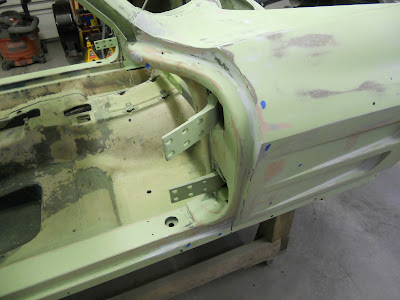Last year we drove our Corvette a total of maybe 15 miles. During that time we noticed the rear end made a clunking noise, especially on turns. Clunking can occur when the differential sits for several years and the internals dry out. The fix can be as simple as doing a series of figure 8's with the car. Unfortunately, that fix didn't correct our problem. Since the rear end still had a clunk and because it wasn't date coded for 1963, we decided to replace it. In this picture Ty is just starting the removal.
An hour or so later the troubled rear end had been removed. It would have been a nightmare to do this had the body been installed. Ty made it look simple but we know better.
The gray unit is the one that was removed. The black one is its replacement and it was purchased on EBay about 6 months ago. It's date coded early 1963, which ours is, and it has 4-11 gears. In 1963 the vast majority of all fuelies came with 4-11 gears so it's perfect for our car.
Dennis K stopped by and helped Ty with the installation. There was a lot of moaning, groaning and cursing needed to install the differential. When it was all done we rolled the car around and verified the clunking noise was gone. Excellent!
1963 Corvettes did not use bearing caps, they used U-bolts like the one I am holding. Since I don't have a full set they will have to be ordered. I'll install them as soon as I get them.
Dewayne J also stopped by. We had an oil leak somewhere between the engine and the bell housing so Dewayne removed the tranny and bell housing for inspection. There wasn't any oil behind the flywheel so we think the leak is coming from the rear of the oil pan. We'll fix that shortly.
While the transmission was out we swapped clutch forks. 1963 clutch forks were unique because they used a ball and socket push rod. The one that's installed now is correct for 1963. All other years are like the one I am holding.
In early 1963 Corvettes used a Borg Warner T10 4-speed transmission. That's what we have and it's correct for our car. Later in 1963 the transmissions were changed to Muncie. One of the issues with the early T10's was they often popped out of 2nd gear. Ours does the same. There are a few things that could cause this, a worn shift fork is one possibility. A new set of these forks are on order and they are easily installed via the transmissions side cover. If that doesn't fix the problem then this tranny will have to be removed and rebuilt. Our fingers are crossed for the shift forks.
The steering on our car was a little sloppy so we decided to remove and rebuild the steering box. When we disassembled the box it had thick grease inside, it should have had 90 weight gear oil. Turns out over the years the exhaust pipe is so close to the steering box that it can cook the oil turning it to grease. We soaked everything in carburetor cleaner for a couple hours then replaced all the bearings and seals and filled it with a high quality 90 weight synthetic gear oil.
It's interesting to note that the carburetor cleaner removed all the black paint but was unable to remove the green House of Kolor primer. That's the same primer we have on our car. It's tough stuff!
The steering box was reinstalled and it's as smooth as silk. It should operate just like it did when new. Note the location of the exhaust pipe.
We will continue to work-off our punch-list items. The body will be reinstalled soon so it's important to make these fixes now while access is good.
Thanks for watching.






































